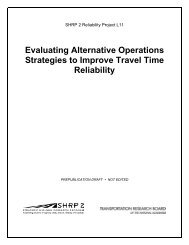Contemporary Approaches to Parking Pricing: - FHWA Operations
Contemporary Approaches to Parking Pricing: - FHWA Operations
Contemporary Approaches to Parking Pricing: - FHWA Operations
You also want an ePaper? Increase the reach of your titles
YUMPU automatically turns print PDFs into web optimized ePapers that Google loves.
Ideally unbundled parking will allow residents and employees <strong>to</strong> purchase parking on a monthly or even daily basis.<br />
In the case of commercial parking the spaces can be rented through the property management association or a thirdparty<br />
parking manager. In the case of residential parking, spaces can be leased through the homeowners’ or umbrella<br />
owners’ association. Each option allows businesses and residents <strong>to</strong> purchase only as much parking as they need.<br />
4.3 <strong>Parking</strong> Taxes and Fees<br />
<strong>Parking</strong> taxes and fees can affect travel behavior by decreasing the amount of available parking, increasing the cost<br />
of parking, or encouraging employers and developers <strong>to</strong> pass the cost of parking on<strong>to</strong> drivers. Fees and taxes do this<br />
by increasing the construction or maintenance cost of parking or by directly increasing parking rates. Drivers are<br />
able <strong>to</strong> respond <strong>to</strong> higher parking rates or lower availability by parking in another location, changing their travel<br />
mode, or changing the timing of their activities (Feitelson and Rotem, 2004). Taxes and fees are most appropriate<br />
when applied <strong>to</strong> parking that is not mandated or required by land use regulations.<br />
The effect of parking taxes and fees is dependent on the type of tax used and the manner in which it is charged.<br />
Taxes can be placed in<strong>to</strong> two primary categories: (1) taxes and fees charged <strong>to</strong> users and (2) taxes and fees charged <strong>to</strong><br />
parking facility owners. User taxes and fees are typically charged on a per-transaction basis. They may be a percentage<br />
of the cost <strong>to</strong> park or a flat amount and typically only affect facilities where users are charged <strong>to</strong> park; although,<br />
such a limitation is not necessary. Taxes and fees charged <strong>to</strong> facility owners can be based on land value, surface area,<br />
or number of available parking spaces. These taxes and fees are extremely flexible: lots that charge parking fees can<br />
be excluded, credits can be issued when preferred spaces are offered <strong>to</strong> carpoolers or car-share vehicles, and garages<br />
and subterranean lots can be excluded or charged based on land area rather than facility square footage. Owner fees<br />
and taxes can exclude facilities that are charging market rates, which allows facilities that are already engaged in<br />
efficient parking management <strong>to</strong> avoid the fees and taxes. Funds from parking taxes and fees can be invested in<br />
transit and other transportation improvements that increase the number of travel options available.<br />
User fees and taxes increase the cost of parking and encourage the use of non-au<strong>to</strong> travel modes and/or the shifting<br />
of travel times. Chicago currently charges a $3.00 per day tax for all vehicles that park in the central business district.<br />
San Francisco has a fee structure that provides a $2.00 discount <strong>to</strong> vehicles that enter a parking garage before<br />
7:30 a.m. or leave after 7:30 p.m. and stay for at least 3 hours (for a <strong>to</strong>tal discount of up <strong>to</strong> $4.00). The discount is<br />
designed <strong>to</strong> encourage travel outside of peak congestion periods. Numerous other cities charge taxes that are a<br />
percentage of parking fees paid by drivers, including Cleveland at 8 percent, Santa Monica at 10 percent, San<br />
Francisco at 25 percent, and Pittsburgh at 37.5 percent, the nation’s highest (Alleghany Institute 2011). The taxes<br />
do not affect parking lots where parking is provided for free.<br />
Selecting an appropriate fee or tax rate must be done carefully. Richard Voith developed a model that identifies<br />
parking tax rates that maximize central business district (CBD) size and land values (1998). His model showed that<br />
appropriate parking taxes can increase land values and community size and that failure <strong>to</strong> charge a tax may result<br />
in excessive congestion, which reduces community size and land value. However, if taxes are set <strong>to</strong>o high the result<br />
will be lower congestion but smaller CBDs and lower land values. Additionally, transaction taxes may encourage<br />
some employers <strong>to</strong> move from paid parking <strong>to</strong> free parking in order <strong>to</strong> avoid the tax.<br />
C o n t e m p o r a r y A p p r o a c h e s t o P a r k i n g P r i c i n g | 19















